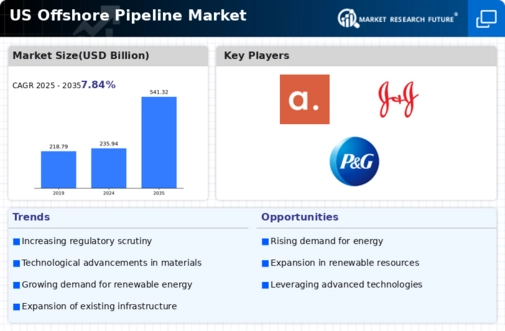Geopolitical Factors
Geopolitical dynamics play a crucial role in shaping the offshore pipeline market. The U.S. is strategically positioned to leverage its offshore resources amidst global energy competition. Tensions in oil-producing regions can lead to supply disruptions, prompting the need for secure and reliable transportation methods. The offshore pipeline market is likely to see increased activity as companies seek to mitigate risks associated with geopolitical uncertainties. Furthermore, the U.S. aims to enhance its energy independence, which may lead to further investments in offshore pipeline projects to ensure a stable supply of energy resources.
Rising Energy Demand
The increasing energy demand in the United States is a primary driver for the offshore pipeline market. As the population grows and industrial activities expand, the need for energy resources, particularly oil and natural gas, intensifies. The U.S. Energy Information Administration (EIA) projects that energy consumption will rise by approximately 10% by 2030. This surge necessitates the development of efficient transportation methods for hydrocarbons, making offshore pipelines a critical component of the energy infrastructure. The offshore pipeline market is poised to benefit from this trend, as companies seek to enhance their supply chains and ensure reliable energy delivery to meet consumer needs.
Environmental Regulations
The offshore pipeline market is increasingly influenced by environmental regulations aimed at minimizing ecological impacts. The U.S. government has implemented stringent guidelines to ensure that offshore pipeline projects adhere to environmental standards. Compliance with these regulations is essential for project approval and can drive innovation within the offshore pipeline market. Companies are investing in advanced technologies and practices to reduce emissions and prevent spills, which may enhance their competitive edge. As environmental concerns continue to rise, the offshore pipeline market is likely to adapt, fostering a culture of sustainability while meeting energy demands.
Technological Advancements
Technological advancements are transforming the offshore pipeline market, enabling more efficient and safer operations. Innovations in materials, monitoring systems, and construction techniques are enhancing the reliability of offshore pipelines. For instance, the adoption of smart pipeline technologies allows for real-time monitoring of pipeline conditions, reducing the risk of leaks and failures. The offshore pipeline market is likely to benefit from these advancements, as they not only improve operational efficiency but also address safety and environmental concerns. As technology continues to evolve, it may lead to cost reductions and increased competitiveness within the market.
Investment in Infrastructure
Significant investments in energy infrastructure are propelling the offshore pipeline market. The U.S. government and private sector are allocating substantial funds to upgrade and expand existing pipeline networks. According to the American Society of Civil Engineers, the U.S. requires an estimated $4.5 trillion investment in infrastructure by 2025. This financial commitment is likely to enhance the offshore pipeline market, as new projects emerge to facilitate the transportation of energy resources from offshore production sites to onshore facilities. Enhanced infrastructure not only improves efficiency but also addresses safety and environmental concerns, further driving market growth.

















Leave a Comment